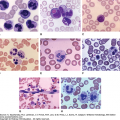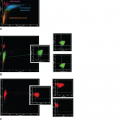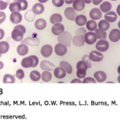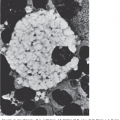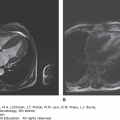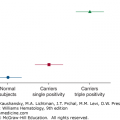INTRODUCTION
SUMMARY
This chapter outlines the category of preneoplastic and neoplastic lymphocyte and plasma cell disorders. It introduces a framework for evaluating neoplastic lymphocyte and plasma cell disorders, outlines clinical syndromes associated with such disorders, and guides the reader to the chapters in the text that discuss each of these disorders in greater detail. Chapter 78 outlines the diseases caused by nonneoplastic disorders of lymphocytes and plasma cells.
Acronyms and Abbreviations
α/β TCR, T-cell-receptor genes encoding the α and β chains of the T-cell receptor (Chap. 76); ALK, gene encoding anaplastic lymphoma kinase; BCL2, gene encoding B-cell chronic lymphocytic leukemia (CLL)/lymphoma 2; BCL6, gene encoding B-cell chronic lymphocytic leukemia (CLL)/lymphoma 6; cIg, cytoplasmic immunoglobulin; EBER, Epstein-Barr-virus-encoded RNA; EBV, Epstein-Barr virus; γ/δ TCR, T-cell-receptor genes encoding the γ and δ chains of the T-cell receptor (Chap. 76); HL, Hodgkin lymphoma; HLA, human leukocyte antigen; HTLV-1, human T-cell leukemia virus type 1; HHV8, human herpes virus 8; Ig, immunoglobulin; IgR, immunoglobulin gene rearrangement (Chap. 75); IL, interleukin; MALT, mucosa-associated lymphoid tissue; MUM1, gene encoding multiple myeloma oncogene 1; neg., negative; NK cell, natural killer cell; NOS, not otherwise specified; NPM, gene encoding nucleophosmin; PAX5, paired box gene 5; POEMS, polyneuropathy, organomegaly, endocrinopathy, monoclonal gammopathy, and skin changes; REAL, revised European-American lymphoma; R-S, Reed-Sternberg; sIg, surface immunoglobulin (Chap. 75); sIgD, surface immunoglobulin D; sIgM, surface immunoglobulin M; TAL1, gene encoding T-cell acute leukemia-1; TCR, T-cell receptor; TdT, terminal deoxynucleotidyl transferase; Th2, T-helper type 2; WHO, World Health Organization.
CLASSIFICATION
Lymphocyte and plasma cell malignancies present a broad spectrum of different morphologic features and clinical syndromes (Table 90–1). Lymphocyte neoplasms can originate from cells that are at a stage prior to T- and B-lymphocyte differentiation from a primitive stem cell or from cells at stages of maturation after stem cell differentiation. Thus, acute lymphoblastic leukemias arise from an early lymphoid progenitor cell that may give rise to cells with either B- or T-cell phenotypes (Chap. 91). On the other hand, chronic lymphocytic leukemia arises from a more mature B-lymphocyte progenitor (Chap. 92) and myeloma from progenitors at even later stages of B-lymphocyte maturation (Chap. 107). Disorders of lymphoid progenitors may result in a broad spectrum of lymphocytic diseases such as B or T cell lymphomas (Chaps. 98 and Chap. 104), hairy cell leukemia (Chap. 93), prolymphocytic leukemia (Chap. 92), natural killer cell large granular lymphocytic leukemia (Chap. 94),1 myeloma, and plasmacytoma (Chap. 107). Hodgkin lymphoma also is derived from a neoplastic B cell that has highly mutated immunoglobulin genes that are no longer expressed as protein (Chap. 97).
| Neoplasm | Morphology | Phenotype* | Genotype† |
|---|---|---|---|
| B-CELL NEOPLASMS | |||
| Immature B-Cell Neoplasms | |||
| Lymphoblastic leukemia/lymphoma not otherwise specified (NOS) (Chap. 91) | Medium to large cells with finely stippled chromatin and scant cytoplasm | TdT+, sIg-, CD10+, CD13+/-, CD19+, CD20-, CD22+, CD24+, CD34+/-, CD33+/-, CD45+/-, CD79a+, PAX5+ | Clonal DJ rearrangement of IGH gene T(17;19), E2A-HLF, AML1 iAMP21 associated with poor prognosis |
| Lymphoblastic leukemia/lymphoma with recurrent genetic abnormalities (Chap. 91) | See above | See above. B-ALL with t(9;22) with CD25 and more frequent myeloid antigens CD13, CD33 | See individual genetic features in B-ALL subtypes below |
| B-ALL with t(v;11q23); MLL rearranged | See above | CD19+, CD10-, CD24-, CD15+ | Multiple MLL (11q23) fusion partners including AF4 (4q21), AF9 (9p22), and ENL (19p13). B-ALL with MLL translocations over express FLT-3. Poor prognosis |
| B-ALL with t(12;21)(p13;q22); TEL-AML1 (ETV6-RUNX1) | See above | CD19+, CD10+, CD34+. Characteristically negative for CD9, CD20, and CD66c | t(12;21)(p13;q22) ETV6-RUNX translocation |
| B-ALL with hyperdiploidy | See above | CD19+, CD10+, CD45-, CD34+ | Numerical increase in chromosomes without structural abnormalities. Most frequent chromosomes +21, X, 14 and 4. +1,2, 3 rarely seen. Favorable prognosis |
| B-ALL with hypodiploidy | See above | See above | Loss of at least one or more chromosomes (range from 45 chromosomes to near haploid). Rare chromosome abnormalities. Poor prognosis |
| B-ALL with t(5;14)(q31;q32); IL3-IGH | See above with increase in reactive eosinophilia | See above. Even rare blasts with B-ALL immunophenotype with eosinophilia strongly suggestive of this subtype of B-ALL | t(5;14)(q31;q32); IL3-IGH leading to overexpression of IL3. Unclear prognosis |
| B-ALL with t(1;19)(q23;p13.3); E2A-PBX1 | See above | CD10+, CD19+, cytoplasmic μ heavy chain. CD9+, CD34- | t(1;19)(q23;p13.3); leads to overexpression of E2A-PBX1 fusion gene product interfering with normal transcription factor activity of E2A and PBX1 |
| Mature B-Cell Neoplasms | |||
| Leukemias | |||
| Chronic lymphocytic leukemia/small lymphocytic lymphoma (Chap. 92) | Small cells with round, dense nuclei | sIg+(dim), CD5+, CD10-, CD19+, CD20+(dim), CD22+(dim), CD23+, CD38+/-, CD45+, FMC-7- | IgR+, trisomy 12 (~30%), del at 13q14 (~50%), 11q22–23, 17p13, and IGHV mutated status associated with poor prognosis |
| Prolymphocytic leukemia (Chap. 92) | ≥55% prolymphocytes | sIg+(bright), CD5+/-, CD10-, CD19+, CD22+, CD23+/-, CD45+, CD79a+, FMC7+ | del13q.14(~30%); del17p (50%), IgR+ |
| Hairy cell leukemia (Chap. 93) | Small cells with cytoplasmic projections | sIg+(bright), CD5-, CD10-, CD11c+(bright), CD19+, CD20+, CD25+, CD45+, CD103+, Annexin A+ | BRAF mutations (~100%), IgR+ |
| Lymphomas | |||
| Lymphoplasmacytic lymphoma (Chap. 109) | Small cells with plasmacytoid differentiation | cIg+, CD5-, CD10-, CD19+, CD20+/- Plasma cell population: CD38+, CD138+, cIgM+ | IgR, 6q- in 50% of marrow-based cases [the t(9;14) was proved to be wrong], +4 (20%) |
| Mantle cell lymphoma (Chap. 100) | Small to medium cells | sIgM+, sIgD+, CD5+, CD10-, CD19+, CD20+, CD23-, Cyclin D1+, FMC-7+, SOX11+ in nearly 100% of cases | IgR, t(11;14)(q13;q32) (~100% by FISH), involving BCL1 and IgH. Highly proliferative variants often show TP53 mutation, deletion of INK4a/ART and p18INK4c |
| Follicular lymphoma (follicle center lymphoma; Chap. 99) | Small, medium, or large cells with cleaved nuclei | sIg, CD5-, CD10+, CD19+, CD20+(bright), CD23-/+, CD38+, CD45+ | IgR, t(14;18)(q32;q21) (~85%) involving BCL2 and IgH. Mutated 3q27 (5-15%, BCL6) |
| Nodal marginal zone B-cell lymphoma (Chap. 101) | Small or large monocytoid cells | sIgM+, sIgD-, cIg+ (~50%), CD5-, CD10-, CD11c+/-, CD19+, CD20+, CD23-, CD43+/- | IgR, commonly with trisomies 3, 7, and 18 |
| Extranodal marginal zone lymphoma of mucosa-associated lymphoid tissue (MALT) type (Chap. 101) | See above | See above | t(11;18)(q21;q21) involving API2, MLT1, or t(1;14)(p22;q32) involving BCL10 |
| Splenic B-cell marginal zone lymphoma | Small round lymphocytes replaces reactive germinal centers and/or villous lymphocytes in blood | sIgM+, sIgD-, CD5+/-, CD19+, CD20+, CD23-, CD103- | IgR, allelic loss of chromosome 7q31–32 (40%) |
| Splenic B-cell lymphoma, unclassifiable | |||
| Splenic diffuse red pulp small B-cell lymphoma | Blood: villous lymphocytes similar to SMZL. Marrow: intrasinusoidal infiltration. Spleen: monomorphous small to medium lymphocytes with round nuclei, vesicular chromatin, occasional small nucleoli | CD20+, DBA.44+, IgG+/IgD-, CD25-, CD5-, CD103-, CD123- | T(9;14)(p13;q32) involving PAX5 and IGH |
| Hairy cell leukemia variant | Hybrid features of prolymphocytic leukemia and classic hairy cell leukemia | sIg+(bright), CD5-, CD10-, CD11c+(bright), CD19+, CD20+, CD25-, CD45+, CD103+, FMC7+, CD123-, Annexin A1-, TRAP– | BRAF mutation negative |
| Diffuse large B-cell lymphoma (DLBCL, Chap. 98) | |||
DLBCL NOS Common Morphologic Variants: | |||
| Centroblastic | Medium to large lymphoid cells with vesicular nuclei containing fine chromatin. Multiple nucleoli | sIgM+, sIgD+/-, CD5-, CD10-/+, CD19+, CD20+, CD22+, CD79a+, CD45+, PAX5+ | IgR, 3q27 abnormalities and/or t(3;14)(q27;q32) involving BCL6 (~30%) or t(14;18)(q32;q21) (~25%) involving BCL2 |
| Immunoblastic | >90% of cells are immunoblasts with central nucleolus | See above. May express CD30+ | See above |
| Anaplastic | Very large round, oval, or polygonal cells with bizarre pleomorphic nuclei resembling R-S cells | See above. Often CD30+ | See above |
| Molecular Subgroups | |||
| Germinal center B cell like (GCB) | See above | See above | See above |
| Activated B-cell–like (ABC) | See above. Often with more immunoblastic morphology | See above | T(14;18) (35%), 12q12 (20%), IG mutation, BCL2 rearrangement (20–25%), Rel amplification (15%). Amplification of microRNA-17-92 cluster |
| Immunohistochemical Subgroups | Gain of 3q (26%), 9p (6%), 12q12 (5%), NF-κB activation | ||
| CD5-positive DLBCL | See above | See above. CD5+ | t(11;14) and t(14;18) negative. +3 and gain on chromosome 16/16p and 18/18q common. Deletion p16/INK4a |
| Nongerminal center B-cell–like (non-GCB) | See above | See above | See above. Uniform FOXP1 expression with IRF4/MUM1 and BCL6 expression |
| Primary mediastinal (thymic) large B-cell lymphoma (Chap. 98) | Variable from case to case. Medium to large cells often with pleomorphic nuclei (R-S–like cells) | sIg-, CD5-, CD10-/+, CD15-, CD19+, CD20+, CD22+, CD23+, CD30+ (80%), CD45+, CD79a+, IRF4/MUM1 (75%). Variable BCL2 (50–80%) and BCL6 (45–100%) expression | IgR+, Gain of 9q24 (75%), gain 2p15 (50%) Amplification of REL, BCL11A, JAK2, PDL1, PDL2. Transcriptome similar to CHL |
| Intravascular large B-cell lymphoma | Neoplastic cells infiltrated within small to intermediate vessels of all organs | CD19+, CD20+, CD5 (38%), CD10 (13%). Lack of CD29 (β1 integrin) and CD54 (ICAM1) may account for intravascular growth pattern | IgR+, otherwise poorly characterized |
| ALK-positive large B-cell lymphoma | Sinusoidal growth pattern, monomorphic large immunoblast-like cells | Strongly positive for ALK, CD138+, VS38+, cytoplasmic IgA or IgG | IgR+, t(2;17) ALK/CLTC |
| Plasmablastic lymphoma | Diffuse proliferation of immunoblasts with plasmacytic differentiation, frequent mitotic figures, monomorphic morphology common in HIV+ patients. Frequently extranodal, EBV+ | CD138+, CD38+, VS38C, IRF4/MUM1+, high Ki67, CD79a+ CD30+ in most cases. Negative for CD45, CD20, PAX5. Cytoplasmic Ig (50–70%). CD56 negative (if positive, suspect plasma cell myeloma) | IgR+, frequently Epstein-Barr virus-encoded RNA (EBER)+ (60–70%) but most cases negative for LMP1. HHV8+ status consistent with large B-cell lymphoma from MCD (below) |
| Large B-cell lymphoma arising from multicentric, HHV8+ Castleman disease (MCD) | HHV8 MCD: B cell follicles with involution and hyalinization of germinal centers with prominent mantle zones. Large plasmablastic cells within mantle zone HHV8 plasmablastic lymphoma. Confluent sheets of HHV8+ LANA1+ cells effacing lymph node architecture. Extranodal involvement common | HHV8+, LANA1+, viral IL6+, cytoplasmic IgM, CD20+/-, Negative for CD79a, CD138, and EBV (EBER) | Polyclonal IgM. IgVH unmutated. IL6R pathway activation. Cytogenetics poorly characterized |
| Primary effusion lymphoma | Range of infiltrating cells with highly abnormal morphology including immunoblastic, plasmablastic, anaplastic. Large nuclei with prominent nucleoli | CD45+, Lack expression of CD19, CD20, CD79a, sIg | IgR+ and hypermutated. No recurrent chromosomal anomalies |
| Burkitt lymphoma (Chap. 98) | Medium cells arranged in diffuse, monotonous pattern. Basophilic cytoplasm, high proliferative index with frequent mitotic figures. “Starry sky” pattern present | Positive for CD19, CD20, CD10, BCL6, CD38, CD77, and CD43. Negative for BCL2 and TdT. Ki67+ in nearly 100% of tumor cells | t(8;14)(q24;q32), t(2;8)(q11;q24), or t(8;22)(q24;q11), involving Ig loci and C-MYC at 8q24 |
| B-cell lymphoma unclassifiable, features intermediate between DLBCL and Burkitt lymphoma (BL) (Chap. 102) | Medium, round cells with abundant cytoplasm. More variation in nuclear size and contour compared to BL. Commonly >90% Ki67+. Unlike BL, can show strong BCL2 expression | Same as above except sIg-, cIg+/-, and CD10- | Same as above except more typically expresses high levels of BCL2 and ~30% have BCL2 rearrangements (double-hit type) |
| B-cell lymphoma unclassifiable, features intermediate between DLBCL and classical Hodgkin lymphoma (HL) | Confluent, diffuse, sheet-like growth of pleomorphic cells within a fibrotic stroma. Pleomorphic cells resembling HL R-S–like cells and lacunar cells. Necrosis frequent | In contrast to HL, CD45+. Positive for CD30 and CD15 | Poorly characterized |
| Plasma Cell Neoplasms | |||
| Monoclonal gammopathy of undetermined significance (MGUS) | Marrow infiltrate with mature plasma cells comprising 1–9% of cellularity | M-protein <30 g/L, marrow <10% plasma cells, no end-organ damage. CD138+. Often difficult to demonstrate LC restriction because of small numbers of plasma cells | Abnormal cytogenetics rarely encountered in MGUS. FISH studies involving IgH occur in ~50% of cases: t(11;14), t(4;14). Del13q. Hyperdiploidy 40% |
| Plasma cell myeloma | Myeloma plasma cells seen in marrow arranged in interstitial clusters | sIg+, CD5-, CD10-, CD19-, CD20-, CD38+(bright), CD45+/-, CD56+, CD117+(bright), CD138+(bright) | IgR, commonly with complex karyotypes and or t(6;14)(p25;q32) involving MUM1. t(11;14) seen in 15–25% cases |
| Extraosseous plasmacytoma | Plasma cells in extraosseous organs must be distinguished from other lymphoproliferative disorders (i.e., MALT type) | Same as plasma cell myeloma | Same as above |
| Solitary plasmacytoma of bone | Plasma cells | Same as plasma cell myeloma | Same as above |
| Monoclonal immunoglobulin deposition disease | Prominent organ (kidney most common, occasionally liver, heart, nerve, blood vessels involved) deposits of nonamyloid, nonfibrillary, amorphous eosinophilic material that does not stain with congo red. Heavy chain (HCDD) and light chain (LCDD) | LCDD is κ light chain predominant. HCDD shows λ chain predominance. Marrow may show abnormal κ/λ ratio | HCDD with VλVI overrepresentation. LCDD with VκIV variable region |
| Hodgkin Lymphoma (Hl) | |||
| Nodular lymphocyte predominant HL (Chap. 97) | “Popcorn cells” with nuclei resembling those of centroblasts | BCL6+, CD19+, CD20+, CD22+, CD45+, CD79a+, CD15-, and rarely CD30+/-, Bob1+, Oct2+, PAX5+ | IgR, with high-level expression of BCL6 |
| Classic Hl (Chap. 97) | |||
| Nodular sclerosis HL | R-S cells and lacunar cells dispersed in reactive lymphoid nodules | R-S cells typically are CD15+, CD20-/+, CD30+, CD45-, CD79a-, PAX5+(dim) | R-S cells generally express PAX5 and MUM1, variable expression of BCL6, and have IgR without functional Ig |
| Lymphocyte-rich HL | Few R-S cells with occasional “popcorn” appearance dispersed in lymphoid nodules | Same as above | Same as above |
| Mixed cellularity HL | R-S cells dispersed among plasma cells, epithelioid histiocytes, eosinophils, and T cells | R-S cells typically are CD15+, CD20-/+, CD30+, CD45-, CD79a- | R-S cells generally express PAX5 and MUM1, variable expression of BCL6, and have IgR without functional Ig |
| Lymphocyte-depleted HL | Prominent numbers of R-S cells with effacement of the nodal structure | Same as above | Same as above |
| T-CELL NEOPLASMS | |||
| Immature T-cell neoplasms | |||
| Lymphoblastic leukemia (Chap. 91) | Medium to large cells with finely stippled chromatin and scant cytoplasm | TdT+, CD2+/-, cytoplasmic CD3+, CD1a+/-, CD5+/-, CD7+, CD10-/+, CD4+/CD8+ or CD4-/CD8-, CD34+/- | Abnormalities in TCR loci at 14q11 (TCR-α), 7q34 (TCR-β), or 7p15 (TCR-γ), and/or t(1;14)(p32-34; q11) involving TAL1 |
| Lymphoblastic lymphoma (Chap. 91) | Same as above | Same as above | Same as above |
| Mature T and NK cell neoplasms | |||
| Leukemias | |||
| T-cell prolymphocytic leukemia (Chap. 104) | Small to medium cells with cytoplasmic protrusions or blebs | TdT-, CD2+, CD3+, CD5+, CD7+, CD4+ and CD8- is more common than CD4- and CD8+, but can be CD4+ and CD8+ | α/β TCR rearrangement, inv14(q11;q32)(~75%). Inv14 in ~80% of cases. Translocations frequently involve TCL1A and TCL1B genes. +8q seen in ~75% cases. del 11q23 and abnormalities with chromosome 6 (33%) and 17P (26%) seen |
| T-cell large granular lymphocytic leukemia (Chap. 94) | Abundant cytoplasm and sparse azurophilic granules | CD2+, CD3+, CD4 -/+, CD5+, CD7+, CD8+/-, CD16+/-, CD56-, CD57+/- | α/β TCR rearrangement, γ/δ rearrangement can be seen |
| Lymphomas/Lymphoproliferative Disorders | |||
| Extranodal T/NK-cell lymphoma, nasal type (“angiocentric lymphoma”; Chaps. 94 and 104) | Angiocentric and angiodestructive growth | CD2+, cytoplasmic CD3+, CD4-, CD5-/+, CD7+, CD8-, CD56+, EBV+ | TCR rearrangements usually neg., EBV present by in situ hybridization |
| Cutaneous T-cell lymphoma (mycosis fungoides; Chap. 103) | Small to large cells with cerebriform nuclei | CD2+, CD3+, CD4+, CD5+, CD7+/-, CD8-, CD25-, CD26+ | α/β TCR rearrangements, complex karyotype common. STAT3 activation |
| Sézary syndrome (Chap. 103) | Same as above | Same as above | Same as above |
